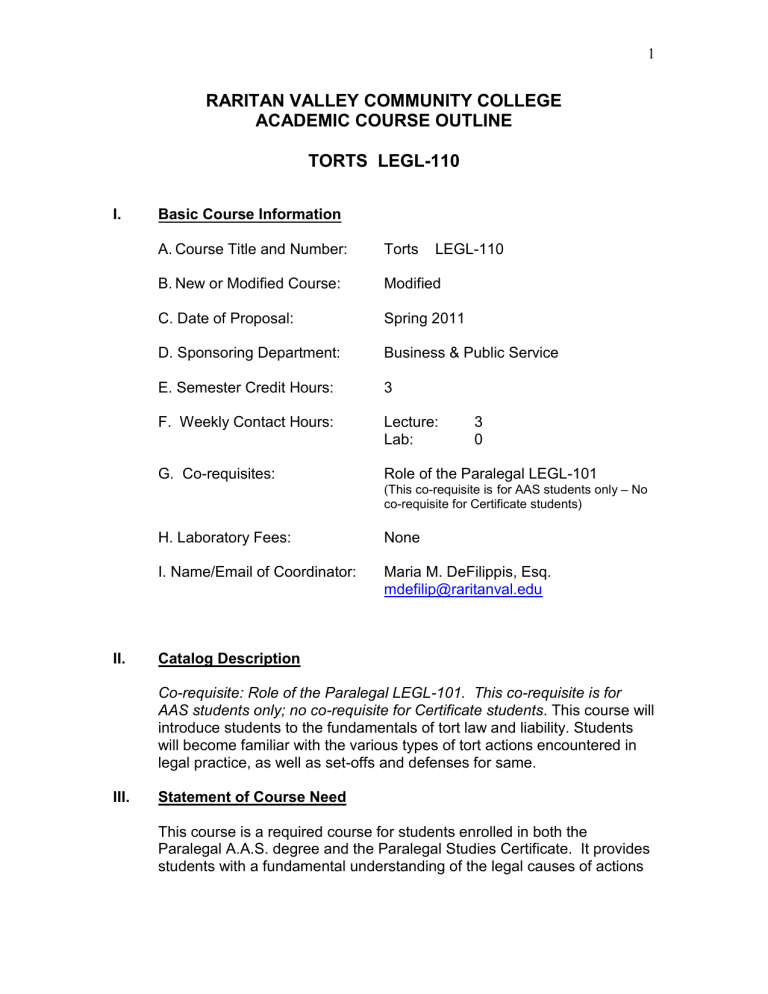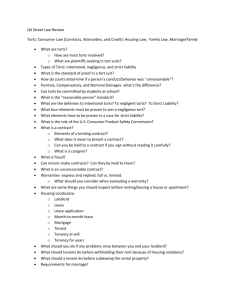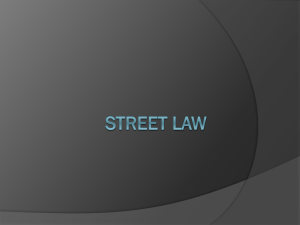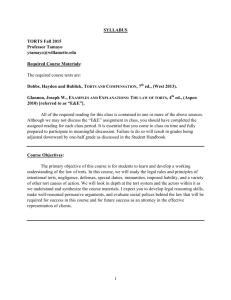LEGL110 Torts - Raritan Valley Community College

1
RARITAN VALLEY COMMUNITY COLLEGE
ACADEMIC COURSE OUTLINE
TORTS LEGL-110
I. Basic Course Information
A. Course Title and Number:
B. New or Modified Course:
C. Date of Proposal:
Torts LEGL-110
Modified
Spring 2011
D. Sponsoring Department:
E. Semester Credit Hours:
F. Weekly Contact Hours:
G. Co-requisites:
Business & Public Service
3
Lecture:
Lab:
3
0
Role of the Paralegal LEGL-101
(This co-requisite is for AAS students only co-requisite for Certificate students)
H. Laboratory Fees: None
I. Name/Email of Coordinator: Maria M. DeFilippis, Esq. mdefilip@raritanval.edu
– No
II. Catalog Description
Co-requisite: Role of the Paralegal LEGL-101. This co-requisite is for
AAS students only; no co-requisite for Certificate students . This course will introduce students to the fundamentals of tort law and liability. Students will become familiar with the various types of tort actions encountered in legal practice, as well as set-offs and defenses for same.
III. Statement of Course Need
This course is a required course for students enrolled in both the
Paralegal A.A.S. degree and the Paralegal Studies Certificate. It provides students with a fundamental understanding of the legal causes of actions
and defenses available in the law as well as the ability to evaluate and understand basic liability issues.
IV. Place of Course in College Curriculum
A. The course is required in the following programs: Paralegal Studies,
AAS Degree and Certificate.
B. This course will transfer to any school with a Paralegal Studies four year degree, which includes Montclair, Thomas Edison, and St.
Elizabeth College in New Jersey. It will also transfer to any four year institution offering an ABA approved paralegal program of study.
V. Outline of Course Content
UNIT I
The first section of the course will consist of an introduction into the basis and analysis of tort law, as well as an in-depth study of the law of negligence.
OUTLINE OF UNIT I CONTENT
A. Initiating a Tort Case
1. Scope of Tort Law and Practice (2 hours)
2. Overview of a Tort Case a. Causes of action defined b. Remedies defined
3. Reading, Briefing and Analyzing Case Law (2 hours)
4. Legal Assistant’s Role in a Tort Case (2 hours) a. File maintenance b. Investigation c. Interviewing d. Pretrial discovery e. Pleadings
B. Negligence f. Trial
1. Overview of a Negligence Action (1 hour) a. duty and its breach b. negligence per se c. damages d. burdens of production and persuasion
2. Duty Owed (3 hours) a. Possessors of land
1. trespassers
2
2. invitees
3. licensees b. Landlord/tenant c. Others
1. rescuers
2. unborn children
3. respondeat superior
4. family purpose doctrine
3. Breach of Duty (1 hour) a. Reasonable care b. Res ipsa loquiter c. Physical disabilities d. Mental deficiencies
4. Causation (1 hour) a. Actual cause b. Proximate cause
5. Damages (1 hour) a. Compensatory b. Punitive c. Nominal d. Types of damages recoverable
1. medical expenses
2. pain and suffering
3. income loss and impaired earnings
4. consortium
5. damage to property
6. Defenses (2 hours) a. Contributory negligence b. Last clear chance doctrine c. Comparative negligence statutes d. Assumption of risk e. Immunity f. Statute of limitations
UNIT II
The next section of the course will include a study of various particular torts including intentional torts such as defamation and malpractice.
Finally, the student will study strict and product liability tort law.
OUTLINE OF UNIT II CONTENT
A. Defamation (3 hours)
1. Elements of a Prima Facie Case a. Nature of defamatory statements
3
b. Publication c. Causation d. Damages
2. Defenses a. Truth b. Consent c. Absolute and conditional privilege d. Mitigation and retraction
B. Malpractice (3 hours)
1. Elements of a Prima Facie Case a. Standards of professional duty b. Breach of duty c. Causation d. Injury and damages
2. Defenses a. Use of experts b. Contributory negligence c. Assumption of risk d. Emergency situations e. Statute of limitations
C. Strict Liability (3 hours)
1. Elements of Prima Facie Case
2. Categories a. Animals b. Abnormally dangerous activities
3. Defenses a. Contributory negligence b. Proximate cause c. Assumption of risk
D. Products Liability
1. Definition and Types
2. Warranty Actions (2 hours) a. Express b. Implied c. Possible defenses
3. Negligence Actions (2 hours) a. Elements b. possible defenses c. advantages and disadvantages
4. Strict Liability Actions (2 hours) a. Elements b. Defective products
1. test
2. manufacturing defects
3. design defects
4. concealed dangers
4
c. Possible defenses d. General uses
UNIT III
The final section of the course will concentrate on types of liability, insurance law and various intentional and miscellaneous torts such as invasion of privacy, nuisance, misrepresentation, assault and trespass.
OUTLINE OF UNIT III CONTENT
A. Intentional Torts (3 hours)
1. Intentional Interference with the Person a. Battery b. Assault c. Infliction of emotional distress d. False imprisonment
2. Intentional Interference with Property a. Trespass b. Conversion
3. Defenses to Intentional Torts a. Necessity b. Privilege c. Mistake d. Consent e. Self defense f. Defense of others g. Defense of property
B. Miscellaneous Torts
1. Misrepresentation (2 hours) a. Fraud and deceit b. Negligent misrepresentation c. Strict liability misrepresentation d. Defenses
2. Nuisance (1 hour) a. Elements b. Defenses
3. Invasion of Privacy (1 hour) a. Definition b. Types
1. appropriation
2. public disclosure of private facts
3. unreasonable intrusion
4. false light c. Defenses
4. Interference with Business Relations (1 hour)
5
a. Definition b. Types
1. interference with existing contracts
2. interference with prospective contracts
3. disparagement of goods
4. trade libel
5. slander of title c. Defenses
5. Misuse of Legal Process (1 hour) a. Definition b. Types
1. malicious prosecution
2. wrongful institution of civil proceedings
3. abuse of process c. Defenses
C. Miscellaneous Issues
1. Vicarious Liability (2 hours) a. Employer/employee b. Independent contractors c. Bailments d. Joint enterprises e. Parental liability
2. Joint Liability (2 hours) a. Independent joint tortfeasors b. Concurrent joint tortfeasors c. Judgment and satisfaction d. Contribution e. Indemnification f. Release
3. Insurance (1 hour) a. Impact b. Types of coverage c. Types of insurance
1. fire/accident/health
2. homeowners/life/auto
4. N.J. Tort Claims Act (1 hour) a. Purpose b. Impact
VI. Educational Goals and Learning Outcomes
A. Education Goals
Students will:
6
7
1. Produce written work that reflects critical and creative thought relative to tort law. (GE NJ 1)
2. Develop the ability to communicate clearly and logically, utilizing both verbal and written skills, in the researching and preparation of legal documents. (GE NJ 1)
3. Use technology and legal specific software to research, collect and organize information to create legal documents such as complaints, answers, discovery devices and memorandums of law. (GE NJ 4)
4. Recognize, analyze and evaluate ethical problems in transaction fact patterns. (GE NJ 9)
B. Learning Outcomes
Upon completion of this course, students will be able to:
1. Analyze legal principles governing the field of tort law.
2. Identify the terminology and legal principles associated with tort law.
3. Compare and contrast the various types of intentional and quasi-intentional torts, negligence suits, products liability, strict liability and breach of warranty actions and their various defenses.
4. Discuss, analyze and evaluate basic tort considerations such as vicarious liability, multiple defendant issues, survival and wrongful death actions, tort immunities and the impact of insurance.
5. Draft legal documents in tort cases, such as complaints, answers, discovery devices and memorandums of law, using legal research methods and specific legal software.
6. Identify ethical considerations in handling tort litigation.
7. Assess the impact of special New Jersey tort considerations such as the N.J. Tort Claims Act and no-fault insurance on client cases.
VII. Modes of Teaching and Learning
This course will employ the following methods of teaching:
A. lecture/discussion
B. small group work & group assignments
C. document preparation by students based on fact patterns
VIII. Papers, Examinations, and other Assessment Instruments
This course will employ the following methods of assessment:
A. Examinations
B. Document preparation assignments based on fact patterns
IX. Grade Determinants
Written exams, class participation and attendance, and written assignments requiring the preparation of various tort documents and memorandums from fact patterns will be used to assess the students according to the general education goals and learning outcomes listed above.
X. Text and Materials
.
A. Textbook: Edwards, Tort Law (Current Edition); Thomson/DelMar
Learning.
B. web sources
C. computer-based and software-specific legal sources
XI. Resources
The course will require the use of computers to present course specific software.
8







